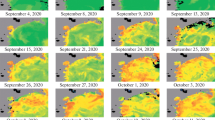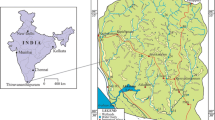Abstract
Tsunami is a serious form of natural disasters that affects the coastal ecosystem. The present paper gives a comparative account of selected hydrobiological parameters of the tsunami affected Kudankulam coast for a period of 32 months from May 2003 to December 2005. The concentration of nitrates, nitrites, and phosphates and phytoplankton density showed higher values immediately after the tsunami. The dissolved oxygen content and the zooplankton abundance decreased considerably. Post-tsunami data indicated that the coastal ecosystem recovered from the impact within five months.
Similar content being viewed by others
References
Altaff, K., Sugumaran, J., & Naveed, M. S. (2005). Impact of tsunami on meiofauna of Marina Beach, Chennai, India. Current Science, 89(1), 34–37.
Cloern, E. (1996). Phytoplankton bloom dynamics in coastal ecosystems: A review with some general lessons from sustained investigation of San Francisco Bay, California. Reviews of Geophysics, 34(2), 127–168. doi:10.1029/96RG00986.
DOD (2005). Preliminary assessment of impact of tsunami in selected coastal areas of India. Department of Ocean Development, Integrated Coastal and Marine Area Management Project Directorate, Chennai, India.
Foster, R., Hagan, A., Perera, N., Gunawan, C. A., Silaban, I., Yaha, Y., et al. (Eds.)(2006). Tsunami and earthquake damage to coral reefs of Aceh. Indonesia. Reef Check Foundation, Pacific Palisades, California, USA.
Graneli, E., Wallstrom, K., Larsson, U., Graneli, W., & Elmgren, R. (1990). Nutrient limitation of primary production in the Baltic Sea area. Ambio, 19, 142–151.
Hamann, M., Limpus, C., Hughes, G., Mortimer, J., & Pilcher, N. (Eds.).(2006). Assessment of the impact of the December 2004 tsunami on marine turtles and their habitats in the Indian Ocean and South-East Asia. IOSEA Marine Turtle MoU Secretariat, Bangkok.
Kannan, L., Sridhar, R., & Thangaradjou, T. (2005). Impact of tsunami on the Mangrove and coastal vegetation of the Nancowry group of Islands in the Nicobar. In T. Balasubramanian, O. J. Fernando, & S. Ravichandran (Eds.), Wave in Bay: Envis Publication Series 3/2005 (pp. 68–76). India: Annamalai University.
Krishnankutty, N. (2006). Effects of 2004 tsunami on marine ecosystems—A perspective from the concept of disturbance. Current Science, 90(6), 772–773.
Kumaraguru, A. K., Jayakumar, K., Wilson, J. J., & Ramakitinan, C. M. (2005). Impact of the Tsunami of 26 December 2004 on the Coral Reef Environment of Gulf of Mannar and Palk Bay in the Southeast Coast of India. Current Science, 89(10), 1729–1741.
Laluraj, C. M., Kesavadas, V., Balachandran, K. K., Gerson, V. J., Martin, G. D., Shaiju, P., et al. (2007). Recovery of an estuary in the southwest coast of India from tsunami impacts. Environmental Monitoring and Assessment, 125(1–3), 41–45. doi:10.1007/s10661-006-9237-2.
Obura, D., & Abdulla, A. (2005). Assessment of tsunami impacts on the marine environment of the Seychelles. Draft-February, 20, 2005. IUCN/UNEP.
Palanivelu, K., Nisha Priya, M., Muthamil Selvan, A., & Natesan, U. (2005). Water quality assessment in the tsunami-affected coastal areas of Chennai. Current Science, 91(5), 583–584.
Ramachandran, S., Anitha, S., Balamurugan, V., Dharanirajan, K., Vendhan, K. E., Divien, M. I. P., et al. (2005). Ecological impact of tsunami on Nicobar Islands (Camrta, Katchal, Nancowry and Trinkat). Current Science, 89(1), 195–200.
Ranjan, R. K. Ramanathan, A., Singh, G., & Chidambaram, S. (2008). Assessment of metal enrichments in tsunamigenic sediments of Pichavaram mangroves, southeast coast of India. Environmental Monitoring and Assessment. doi:10.1007/s10661-007-0128-y.
Rao, D. V. S., Ingole, B., Tang, D., Satyanarayan, B., & Zhao, H. (2007). Tsunamis and marine life. In T. S. Murthy, U. Aswathanarayana, & N. Nirupama (Eds.), The Indian Ocean tsunami (pp. 373–391). Taylor and Francis.
Reddy, H. R. V., Katti, R. J., Raveesha, K. P., Vikas, S. J., & Nagendra babu, K. S. (2005). Coastal water quality off Dakshina Kannada before and after tsunami. Current Science, 88(7), 1027–1029.
Sampath, V. (2005). Possible impacts of 26th December 2004 tsunami on marine bioresources of Bay of Bengal. In T. Balasubramanian, O. J. Fernando, & S. Ravichandran (Eds.), Wave in Bay: Envis Publication Series 3/2005 (pp. 10–18). India: Annamalai University.
Sastry, A. G. R. (1987). Studies on the hydrography and plankton of a tropical tidal estuary (The Vasishta Godavari) on the east coast of India. Ph.D dissertation, Andhra University, India.
UNEP (2006). Marine and coastal ecosystems and human wellbeing: A synthesis report based on the findings of the Millennium Ecosystem Assessment. (UNEP from www.MAweb.org).
Venugopalan, V. K., & Paulpandian, A. L. (1989). Methods in hydrobiology. India: CAS in Marine Biology, Annamalai University Publications.
Author information
Authors and Affiliations
Corresponding author
Rights and permissions
About this article
Cite this article
Satheesh, S., Godwin Wesley, S. Impact of December 26, 2004 tsunami on the hydrobiology of Kudankulam coast, Gulf of Mannar, India. Environ Monit Assess 156, 131–139 (2009). https://doi.org/10.1007/s10661-008-0469-1
Received:
Accepted:
Published:
Issue Date:
DOI: https://doi.org/10.1007/s10661-008-0469-1




